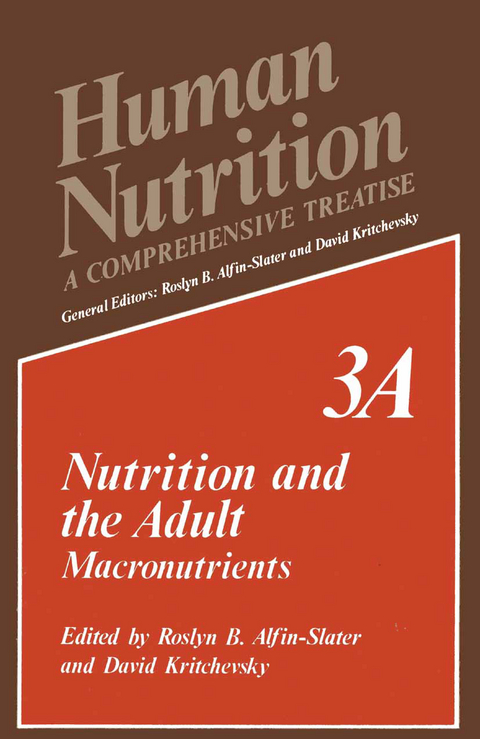
Nutrition and the Adult
Springer-Verlag New York Inc.
978-1-4613-3017-2 (ISBN)
1 Nutrient Requirements: What They Are and Bases for Recommendations.- 1. Introduction.- 2. Techniques Used to Determine Nutritional Status.- 3. Standards of Nutrient Intake.- 4. Energy.- 5. Fats.- 6. Protein.- 7. Vitamins.- 8. Mineral Elements.- 9. References.- 2 Energy: Caloric Requirements.- 1. Brief History of Bioenergetics.- 2. Definitions.- 3. Calorimetry.- 4. Assessing Energy Balance.- 5. Caloric Allowances.- 6. Metabolic Size.- 7. Caloric Content of Foods.- 8. Methods of Determining Caloric Content of Foods.- 9. Calories and Obesity.- 10. Undernutrition.- 11. Source of Calories during Exercise.- 12. References.- 3 Suppliers of Energy: Carbohydrates.- 1. Introduction.- 2. Digestion.- 3. Carbohydrate Tolerance Tests.- 4. Carbohydrate Metabolism in the Liver.- 5. Carbohydrates and Muscle.- 6. Carbohydrates and Adipose Tissue.- 7. Carbohydrate Metabolism in the Brain.- 8. Carbohydrate Metabolism in the Fetus and Neonate.- 9. Carbohydrate and Lipid Metabolism.- 10. Factors Affectingthe Metabolic Response to Dietary Carbohydrate.- 11. Carbohydrates in the Etiology of Disease.- 12. Other Carbohydrates Consumed by Humans.- 13. Conclusion.- 14. References.- 15. Further Reading.- 4 Suppliers of Energy: Fat.- 1. Introduction.- 2. Distribution of Lipids in the Diet.- 3. Triglycerides: Physical and Chemical Properties.- 4. Digestion and Absorption.- 5. Transport.- 6. Utilization of Fats by Tissues.- 7. Fat as an Energy. Source.- 8. Fatty Acid Isomerism.- 9. Conclusions.- 10. References.- 5 Suppliers of Energy: Carbohydrate-Fat Interrelationships.- 1. Introduction.- 2. Growth.- 3. Obesity.- 4. Diabetes.- 5. Blood Lipids.- 6. Exercise.- 7. References.- 6 Energetics and the Demands for Maintenance.- 1. Introduction.- 2. Measurement of Energy Exchange.- 3. Partition of Food Energy.- 4. Conclusion.- 5. References.- 7 Nutrients with Special Functions: Proteins and Amino Acids in Tissue Maintenance.- 1. Introduction.- 2. Hydrolysis and Absorption of Dietary Protein.- 3. Meal-Related Interorgan Movements of Amino Acids.- 4. Protein Synthesis.- 5. Protein Breakdown.- 6. Interrelationships of Amino Acid Supply and Protein and Nucleic Acid Metabolism.- 7. Overall Total-Body Protein Synthesis and Breakdown.- 8. General Conclusions.- 9. References.- 8 Nutrients with Special Functions: Essential Fatty Acids.- 1. What Are the Essential Fatty Acids?.- 2. How Do We Name the Essential Fatty Acids?.- 3. What Structures Confer Essential Fatty Acid Activity?.- 4. How Are the Essential Fatty Acids Obtained?.- 5. How Are the Essential Fatty Acids Synthesized and Altered?.- 6. How Is Essential Fatty Acid Deficiency Established?.- 7. How Do We Recognize Essential Fatty Acid Deficiency in Experimental Animals?.- 8. What About Deficiency Symptoms in Humans?.- 9. What Actually Is the Function of the Essential Fatty Acids?.- 10. What Is an Adequate Intake of Essential Fatty Acids?.- 11. What About Excess Essential Fatty Acids?.- 12. Conclusions.- 13. References.- 9 Nutrients with Special Functions: Cholesterol.- 10 Nutrients with Special Functions: Dietary Fiber.- 1. Introduction.- 2. A Definition of Fiber.- 3. The Composition of Fiber.- 4. Intestinal Function and Disease.- 5. Lipid Metabolism and Atherosclerosis.- 6. Diabetes Mellitus.- 7. Overconsumption of Fiber.- 8. Summary.- 9. References.
| Reihe/Serie | Human Nutrition ; 3A |
|---|---|
| Zusatzinfo | 308 p. |
| Verlagsort | New York, NY |
| Sprache | englisch |
| Maße | 170 x 244 mm |
| Themenwelt | Medizin / Pharmazie ► Gesundheitsfachberufe ► Diätassistenz / Ernährungsberatung |
| Naturwissenschaften ► Biologie ► Biochemie | |
| ISBN-10 | 1-4613-3017-3 / 1461330173 |
| ISBN-13 | 978-1-4613-3017-2 / 9781461330172 |
| Zustand | Neuware |
| Haben Sie eine Frage zum Produkt? |
aus dem Bereich


